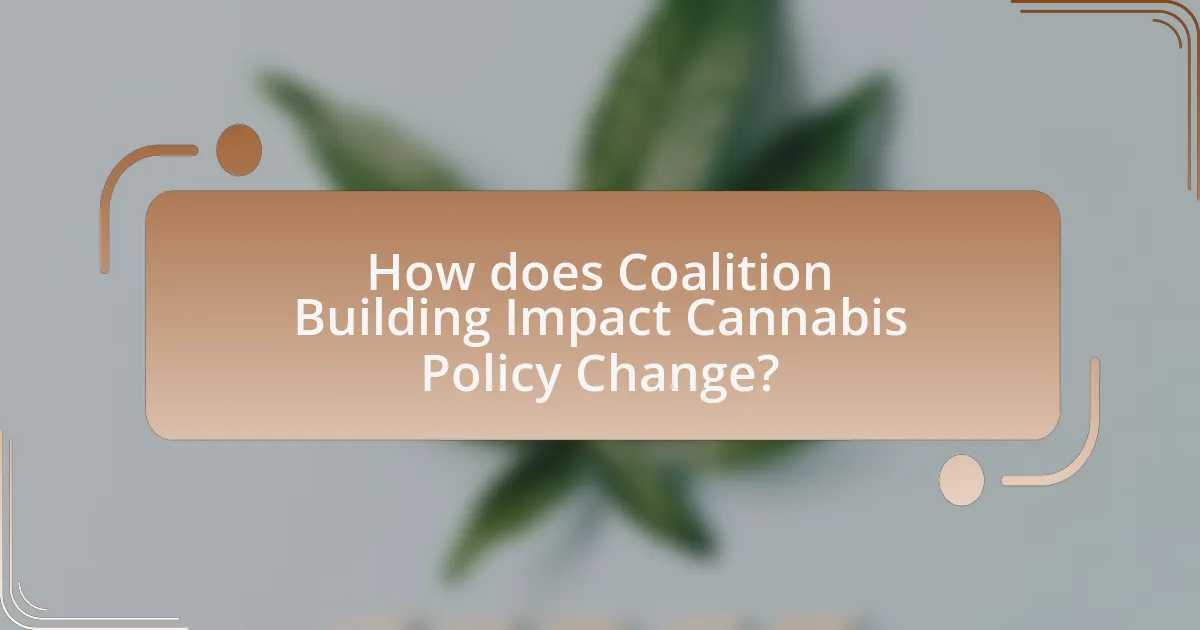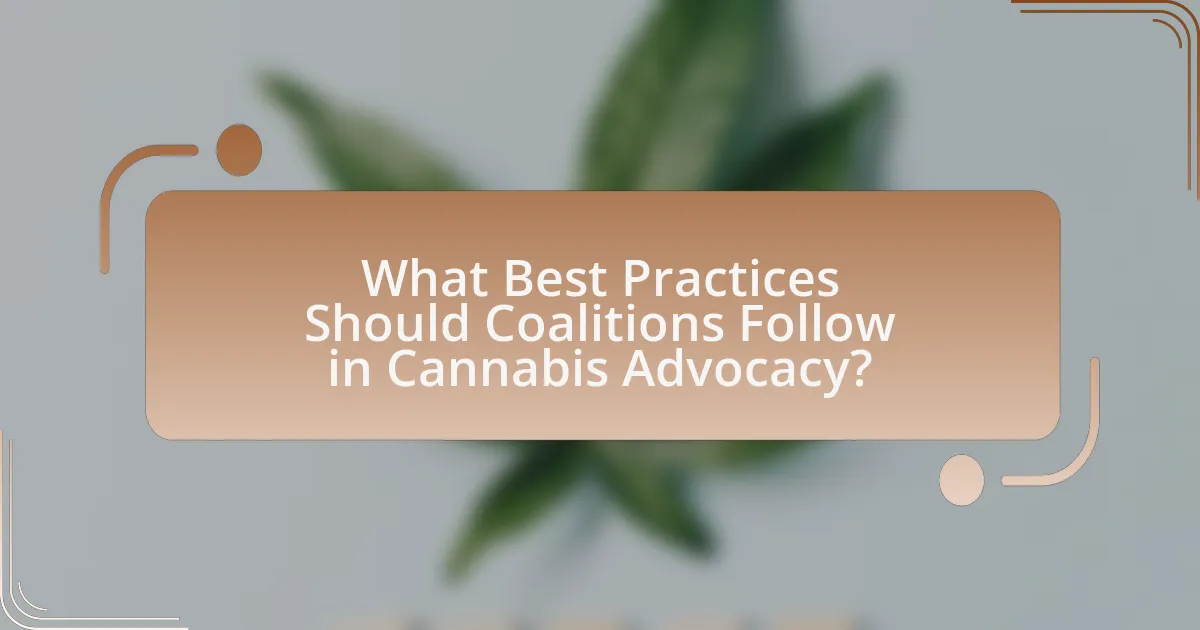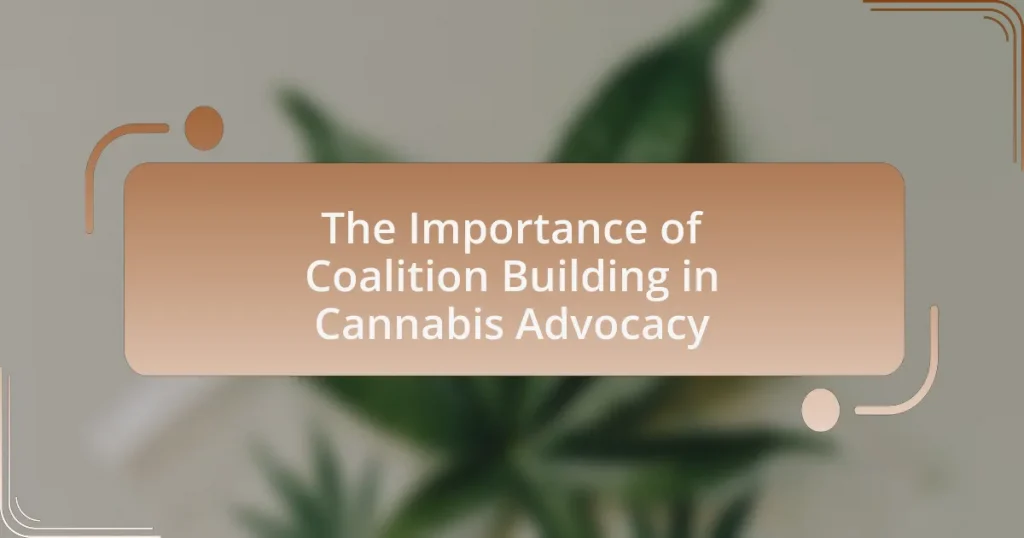Coalition building in cannabis advocacy is the process of forming alliances among diverse stakeholders, including patients, medical professionals, business owners, and social justice organizations, to promote shared goals related to cannabis policy reform. This article outlines the significance of coalition building, emphasizing its role in enhancing advocacy efforts through increased visibility, resource pooling, and unified messaging. Key elements of effective coalitions, such as shared goals, strong leadership, and clear communication, are discussed, along with the challenges coalitions face, including differing agendas and legal complexities. The article also highlights successful case studies and best practices for sustaining momentum and fostering inclusive participation in cannabis advocacy.

What is Coalition Building in Cannabis Advocacy?
Coalition building in cannabis advocacy refers to the process of forming alliances among diverse stakeholders to promote shared goals related to cannabis policy reform. This approach enhances the effectiveness of advocacy efforts by uniting various groups, such as patients, medical professionals, business owners, and social justice organizations, to create a stronger, collective voice. Research indicates that coalitions can significantly increase the likelihood of successful legislative outcomes, as seen in states where collaborative efforts have led to the legalization of medical and recreational cannabis.
Why is Coalition Building Essential for Cannabis Advocacy?
Coalition building is essential for cannabis advocacy because it unites diverse stakeholders to create a stronger, more effective movement. By bringing together various groups—such as patients, medical professionals, entrepreneurs, and social justice advocates—coalitions amplify their collective voice, increasing visibility and influence in policy discussions. Research indicates that collaborative efforts can lead to more comprehensive legislative changes, as seen in states where coalitions successfully advocated for legalization and reform, resulting in significant shifts in public policy and perception.
What are the key elements of effective coalition building?
The key elements of effective coalition building include shared goals, diverse membership, strong leadership, clear communication, and mutual trust. Shared goals ensure that all members are aligned in their objectives, which is crucial for maintaining focus and motivation. Diverse membership brings together various perspectives and resources, enhancing the coalition’s capacity to address complex issues. Strong leadership is essential for guiding the coalition, facilitating collaboration, and resolving conflicts. Clear communication fosters transparency and understanding among members, which is vital for coordination and engagement. Finally, mutual trust among coalition members strengthens relationships and encourages collaboration, making the coalition more resilient and effective in achieving its objectives.
How does coalition building enhance advocacy efforts?
Coalition building enhances advocacy efforts by uniting diverse stakeholders to amplify their collective voice and influence. This collaboration allows for pooling resources, sharing expertise, and increasing visibility, which can lead to more effective campaigns. For instance, in cannabis advocacy, coalitions can bring together activists, medical professionals, and business leaders, creating a stronger front that can sway public opinion and policymakers. Research indicates that coalitions can increase the likelihood of achieving policy change by 50%, demonstrating their significant impact on advocacy outcomes.
Who are the stakeholders involved in Coalition Building?
The stakeholders involved in coalition building in cannabis advocacy include advocacy groups, policymakers, industry representatives, healthcare professionals, and community organizations. Advocacy groups work to promote cannabis legalization and reform, while policymakers create and implement laws affecting cannabis use. Industry representatives, such as cannabis businesses and entrepreneurs, contribute insights on market dynamics and economic impacts. Healthcare professionals provide expertise on medical cannabis benefits and risks, and community organizations engage local populations to ensure diverse perspectives are represented. Each stakeholder plays a crucial role in shaping the coalition’s goals and strategies, facilitating a comprehensive approach to cannabis advocacy.
What roles do advocacy groups play in coalition building?
Advocacy groups play a crucial role in coalition building by uniting diverse stakeholders to amplify their collective voice and influence policy change. These groups facilitate collaboration among various organizations, ensuring that different perspectives and resources are integrated into a cohesive strategy. For instance, in cannabis advocacy, groups like the National Organization for the Reform of Marijuana Laws (NORML) have successfully partnered with medical associations, civil rights organizations, and business coalitions to promote legalization efforts. This collaboration enhances credibility and broadens the reach of advocacy campaigns, ultimately leading to more effective lobbying and public awareness initiatives.
How do policymakers influence coalition dynamics?
Policymakers influence coalition dynamics by shaping the regulatory environment and funding opportunities that affect coalition strategies and priorities. For instance, when policymakers introduce supportive legislation for cannabis advocacy, they can enhance coalition cohesion by aligning member goals with favorable legal frameworks. Additionally, policymakers can facilitate or hinder coalition activities through their decisions on resource allocation, which directly impacts the capacity of coalitions to mobilize and advocate effectively. Historical examples include the passage of the 2018 Farm Bill in the United States, which legalized hemp and significantly strengthened coalitions advocating for cannabis reform by providing a clearer regulatory landscape and access to federal resources.
What challenges do coalitions face in Cannabis Advocacy?
Coalitions in cannabis advocacy face several challenges, including fragmentation of interests, varying levels of commitment among members, and legal complexities. Fragmentation occurs when different groups prioritize distinct aspects of cannabis policy, leading to conflicting agendas that hinder unified action. Additionally, varying levels of commitment can result in unequal participation, where some members may not contribute as actively, weakening the coalition’s overall effectiveness. Legal complexities arise from the inconsistent regulatory landscape across jurisdictions, complicating advocacy efforts and creating barriers to cohesive messaging. These challenges can impede the coalition’s ability to influence policy effectively and achieve common goals.
How can differing agendas impact coalition effectiveness?
Differing agendas can significantly undermine coalition effectiveness by creating conflicts that hinder collaboration and decision-making. When coalition members prioritize their individual goals over shared objectives, it leads to misalignment and fragmentation within the group. For instance, a study by the National Coalition for Dialogue & Deliberation highlights that coalitions with clear, unified goals are more successful in achieving their objectives, while those with competing interests often struggle to maintain cohesion and focus. This misalignment can result in wasted resources, decreased morale, and ultimately, failure to influence policy effectively in cannabis advocacy.
What strategies can overcome common coalition challenges?
Effective strategies to overcome common coalition challenges include establishing clear communication channels, defining shared goals, and fostering trust among members. Clear communication ensures that all coalition members are informed and aligned, reducing misunderstandings that can lead to conflict. Defining shared goals creates a unified vision, which is essential for collaboration and maintaining focus on the coalition’s objectives. Fostering trust among members encourages open dialogue and collaboration, which is vital for addressing issues as they arise. Research indicates that coalitions with strong communication and trust are more successful in achieving their objectives, as evidenced by studies on collaborative governance in advocacy settings.

How does Coalition Building Impact Cannabis Policy Change?
Coalition building significantly impacts cannabis policy change by uniting diverse stakeholders to advocate for reform. This collaboration amplifies voices, increases resources, and enhances credibility, making it more likely to influence policymakers. For instance, successful coalitions in states like California and Colorado have led to the legalization of cannabis through coordinated efforts that combined advocacy groups, medical professionals, and business interests, demonstrating that a unified approach can effectively shift public opinion and legislative outcomes.
What are the measurable outcomes of successful coalitions?
Measurable outcomes of successful coalitions include increased legislative support, enhanced public awareness, and improved resource allocation. For instance, coalitions in cannabis advocacy have successfully influenced policy changes, as seen in states like California, where coalition efforts led to the legalization of recreational cannabis in 2016, reflecting a significant shift in public policy. Additionally, successful coalitions often report higher engagement levels among stakeholders, evidenced by increased participation in advocacy events and campaigns, which can be quantified through attendance records and social media metrics. These outcomes demonstrate the effectiveness of collaborative efforts in achieving specific goals within the cannabis advocacy landscape.
How do coalitions influence legislative processes?
Coalitions influence legislative processes by uniting diverse stakeholders to advocate for common goals, thereby amplifying their collective voice and increasing their impact on policy decisions. For instance, in cannabis advocacy, coalitions comprising activists, medical professionals, and business leaders can effectively lobby legislators by presenting unified positions, sharing resources, and mobilizing public support. This collaborative approach has been shown to lead to successful legislative outcomes, such as the legalization of cannabis in various states, where coalition efforts have resulted in significant public awareness and shifts in public opinion, ultimately influencing lawmakers’ decisions.
What case studies illustrate successful coalition outcomes?
Successful coalition outcomes in cannabis advocacy can be illustrated by the case studies of the Coalition for Cannabis Policy Reform in California and the Marijuana Policy Project’s efforts in various states. The Coalition for Cannabis Policy Reform successfully united diverse stakeholders, including medical professionals, civil rights organizations, and business groups, leading to the passage of Proposition 64 in 2016, which legalized recreational cannabis in California. This coalition’s effectiveness was evidenced by the broad support it garnered, with over 57% of voters approving the measure. Similarly, the Marijuana Policy Project has successfully built coalitions in states like Colorado and Massachusetts, where collaborative efforts among advocacy groups, lawmakers, and community organizations resulted in the legalization of cannabis through ballot initiatives and legislative action. These case studies demonstrate that strategic coalition building can lead to significant policy changes in cannabis advocacy.
How does public perception affect coalition building?
Public perception significantly influences coalition building by shaping the willingness of diverse groups to collaborate. When the public views cannabis advocacy positively, organizations are more likely to unite, as they perceive a shared goal aligned with societal values. For instance, a 2021 Gallup poll indicated that 68% of Americans support legalizing cannabis, demonstrating a favorable public perception that encourages coalition formation among advocacy groups, policymakers, and businesses. Conversely, negative public perception can lead to fragmentation, as groups may hesitate to associate with a cause perceived as controversial or stigmatized. Thus, the alignment of public perception with coalition goals is crucial for effective collaboration in cannabis advocacy.
What role does media play in shaping public opinion on cannabis advocacy?
Media plays a crucial role in shaping public opinion on cannabis advocacy by influencing perceptions and disseminating information. Through various platforms, including news outlets, social media, and documentaries, media coverage can highlight the benefits and challenges of cannabis use, thereby swaying public attitudes. For instance, studies have shown that positive media portrayals of cannabis legalization correlate with increased public support; a 2018 survey indicated that states with favorable media coverage experienced a 10% rise in support for legalization initiatives. This demonstrates that media not only informs but also actively shapes the discourse surrounding cannabis advocacy, impacting legislative outcomes and public perception.
How can coalitions effectively communicate their message to the public?
Coalitions can effectively communicate their message to the public by utilizing clear, consistent messaging across multiple platforms. This approach ensures that the coalition’s objectives and values are easily understood and resonate with diverse audiences. For instance, research indicates that campaigns employing a unified message across social media, traditional media, and community events achieve higher engagement rates, as seen in the 2018 cannabis legalization efforts in Canada, where coordinated messaging led to increased public support. Additionally, coalitions should leverage storytelling to humanize their cause, making it relatable and compelling, which has been shown to enhance emotional connections with the audience.

What Best Practices Should Coalitions Follow in Cannabis Advocacy?
Coalitions in cannabis advocacy should prioritize collaboration, transparency, and community engagement. Effective collaboration among diverse stakeholders enhances the coalition’s ability to address complex issues and mobilize resources. Transparency in decision-making fosters trust and accountability, which are essential for maintaining strong relationships within the coalition and with the public. Engaging the community ensures that advocacy efforts reflect the needs and concerns of those directly affected by cannabis policies. Research indicates that coalitions that actively involve community members are more successful in achieving policy changes, as seen in the 2020 study by the Drug Policy Alliance, which highlighted the importance of grassroots involvement in advocacy efforts.
What strategies enhance coalition effectiveness?
Effective coalition strategies include establishing clear goals, fostering open communication, and building trust among members. Clear goals align the coalition’s efforts and provide a shared vision, which is essential for coordinated action. Open communication ensures that all members are informed and engaged, facilitating collaboration and problem-solving. Trust among coalition members enhances cooperation and commitment, leading to more effective advocacy efforts. Research indicates that coalitions with strong interpersonal relationships and shared objectives are more successful in achieving their aims, as demonstrated in studies on community organizing and advocacy effectiveness.
How can coalitions foster inclusive participation?
Coalitions can foster inclusive participation by creating a platform that amplifies diverse voices and perspectives within the cannabis advocacy movement. By bringing together various stakeholders, including marginalized communities, coalitions ensure that all relevant viewpoints are represented in decision-making processes. Research indicates that inclusive coalitions lead to more effective advocacy outcomes, as they harness a broader range of experiences and expertise, ultimately resulting in policies that better reflect the needs of the entire community. For instance, the National Cannabis Industry Association emphasizes the importance of inclusivity in their initiatives, demonstrating that diverse representation can enhance credibility and support for cannabis reform efforts.
What tools can support coalition communication and collaboration?
Tools that can support coalition communication and collaboration include platforms like Slack, Microsoft Teams, and Zoom. These tools facilitate real-time messaging, video conferencing, and file sharing, which are essential for effective communication among coalition members. For instance, Slack allows for organized discussions through channels, while Microsoft Teams integrates with other Microsoft applications for seamless collaboration. Zoom provides a reliable platform for virtual meetings, enabling face-to-face interactions regardless of geographical barriers. These tools enhance coordination and information sharing, which are critical for successful coalition efforts in cannabis advocacy.
What are the key takeaways for building successful coalitions?
Key takeaways for building successful coalitions include establishing clear goals, fostering open communication, and ensuring diverse representation. Clear goals align coalition members towards a common purpose, enhancing focus and effectiveness. Open communication builds trust and facilitates collaboration, allowing for the sharing of ideas and resources. Diverse representation brings varied perspectives and expertise, which strengthens the coalition’s ability to address complex issues in cannabis advocacy. Research indicates that coalitions with these characteristics are more likely to achieve their objectives and create lasting impact in their communities.
How can coalitions sustain momentum over time?
Coalitions can sustain momentum over time by establishing clear goals, maintaining open communication, and fostering strong relationships among members. Clear goals provide direction and purpose, ensuring that all coalition members are aligned in their efforts. Open communication facilitates transparency and collaboration, allowing members to share updates, challenges, and successes, which keeps the coalition engaged and motivated. Strong relationships among members enhance trust and commitment, encouraging ongoing participation and support. Research indicates that coalitions with defined objectives and effective communication strategies are more likely to achieve long-term success and maintain active involvement (Butterfoss, 2007, “Coalition Effectiveness: A Review of the Literature,” American Journal of Preventive Medicine).
What common pitfalls should coalitions avoid?
Coalitions should avoid lack of clear communication, which can lead to misunderstandings and conflicts among members. Effective communication ensures that all stakeholders are aligned on goals and strategies, reducing the risk of fragmentation. Additionally, coalitions must steer clear of failing to establish defined roles and responsibilities, as this can result in overlapping efforts or gaps in action. Research indicates that coalitions with clear structures are more successful in achieving their objectives. Furthermore, coalitions should avoid neglecting to engage diverse perspectives, as inclusivity fosters innovation and strengthens advocacy efforts. A study by the National Coalition for Dialogue & Deliberation highlights that diverse coalitions are more effective in addressing complex issues. Lastly, coalitions must not overlook the importance of sustainability; without a plan for long-term engagement and resource allocation, initiatives may falter after initial successes.
What practical steps can advocates take to build coalitions?
Advocates can build coalitions by identifying shared goals and values among diverse stakeholders. This involves conducting outreach to potential partners, such as community organizations, businesses, and individuals who share an interest in cannabis advocacy. Establishing clear communication channels is essential for fostering collaboration and trust. Regular meetings and collaborative events can help maintain engagement and momentum. Additionally, leveraging social media and public forums can raise awareness and attract new coalition members. Research indicates that coalitions with diverse representation are more effective in achieving policy changes, as seen in the successful campaigns for cannabis legalization in various states, which often involved broad coalitions of advocates, medical professionals, and community leaders.


